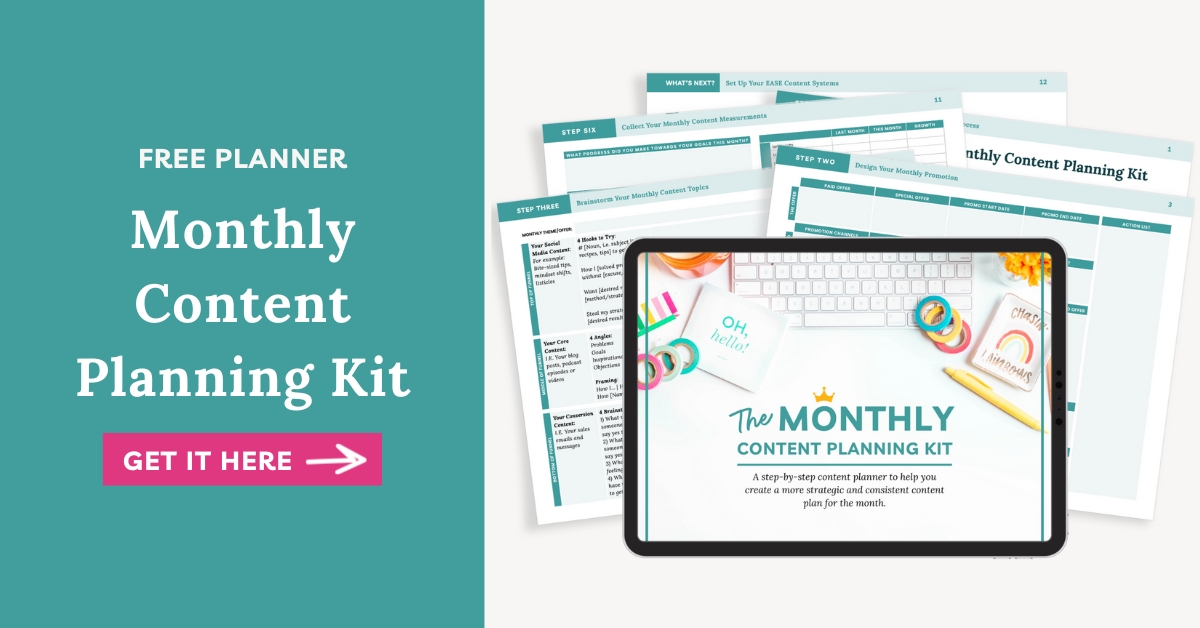
Sign up to get instant access to the Monthly Content Planning Kit!
Want more profitable + strategic content? Grab my free content planner!


I’m Hailey – content strategist and founder here at Your Content Empire where we help you create more profitable, purposeful and productive content — and hopefully enjoy yourself more while doing it too. Learn more about me here >>

Do you have a monthly membership that you’re struggling to get new members in? Or maybe you have a steady stream of new members, but you want to scale it so you have a higher monthly recurring revenue? In this video, I’m giving you the ultimate monthly marketing plan for memberships—all done for you.
Memberships are one of my favourite business models from a content standpoint. There’s so much opportunity to overlap your work inside the membership with what you’re sharing publicly to generate interest and leads for that membership.
This strategy that I’m covering comes from the last few clients I’ve coached who have memberships but were really struggling to balance creating content for that membership and marketing it externally.
This works best for memberships that have either monthly content that’s being released or themes for the month that they’re covering – even if it’s something that cycled through.
For instance, one client is fractional CFO who just crossed the 6 month mark for his membership (yay!) and he launched that membership as a way of getting to work with and support more business owners than just the ones who he had capacity to work with one on one. Every month, he hosts a masterclass on a particular theme, that leads into a challenge for implementing that theme and then a coworking session for a space and place for members to get support and take action. The themes of the challenges and masterclasses are things like: your monthly bookkeeping system, how to forecast your expenses and income, how to build a paid ad system that makes sense from a ROI perspective, tax prep finish line. The plan for next year, is to run these same themes in the months where they make the most sense even if he’s adding a few bells and whistles that second time around. What’s nice is that it means most of his work and time investment for the membership is relegated to year one.
But that stills leaves us with the challenge of (1) how to market your membership; and (2) how to do it in a way that leverages the content you’re creating internally for your members without giving everything away.
Let’s tackle those challenges head on ↓
Structurally, the strategy is pretty simple.
Every month, you’re going to work on the content for the next month in your membership. Whether that’s a masterclass, a challenge, templates, a mini course or some combination of these.
You’ll start by picking the theme or topic for the upcoming month.
Then, as you’re working on that membership content, you’ll also prepare teaser content to share externally in weeks 1-3 of the month. This is so you can “gather” anyone who’s interested in that particular theme or topic from your audience AND add new people to your audience who are interested in that theme as well.
Then, in week 4, you switch your messaging from free, value content to inviting them to join the membership so they can dive deeper into the theme and get whatever related results they most desire.
What I love most about this method is that it perfectly supports the cycle of a membership and helps you from having to context switch when creating content for your internal and external audiences. The scope may be different but you’re able to stay on theme.
The first thing we have to do though is plan your topics. How do you create external content on your theme without giving everything away?
Well, step 1 is to choose your theme of the month.
Here are some examples:
After you have your theme for the month chosen, and this assuming, you already know what’s included in your monthly membership and how the theme is delivered (is it a workshop? is it a challenge? is it templates?)
But after you have your theme, it’s time to brainstorm your external content so you can work on and publish it while continuing to work on the membership content for the next month.
Here’s what I recommend: Take the topic or theme and brainstorm the following:
Next it’s time to prep your content ↓
Think of week 1 of the month as your thematic kick-off. The entire goal of the first 3 weeks is to generate interest in your membership from anyone who’s a good fit based on their interest in the topic you’ll be covering in the membership in the following month. What’s great about that is that it means, every single month as you’re introducing new themes, you’ll have an opportunity to appeal to an entirely different segment of your list who is drawn to that particular theme.
In terms of core content, you’ll create a long-form blog post, podcast episode or video on the PROBLEM you brainstormed in the earlier step we covered.
Your social content can be pulled from this long-form post but should all be focused on the problems related to the upcoming membership theme.
And if you feel like getting fancy, a good addition to this three weeks of content is to have some kind of freebie related to the theme that people can sign up for you if they’re interested in it. You can use this as the call to action on your long-form content. It’s a good way to make sure you can get back in touch with anyone who has expressed interest in the theme when you switch to “selling” in week 4.
Let’s go through a few examples of problem posts:
So that’s week 1. With week 2, we’re shifting into focusing on the people who are now solution aware. They know they have a problem they want solved. They know what the solution to the problem is (and it’s aligned with how you solve it).
For your long-form content, you’ll create a written blog post, podcast episode or video on the GOAL you brainstormed in the earlier planning step.
Just like before your social content can be pulled from this long-form post and your call to action for the long-form content is ideally going to be that simple PDF related to the theme. Think something simple like a cheat sheet, journaling sheet, planning sheet, etc.
Let’s cover some examples:
Moving on to week 3, this is usually the last week of “interest generation” content before shifting into sales invitations.
The long-form content this week is based on the OBJECTION topic you brainstormed in the planning phase.
Some examples:
After you’ve run these three weeks, you should have a really good idea of who in your general email list is interested in this theme. You should have also added new leads onto your email list from those who are interested in this theme. Now that we know who these folks are, it’s time to invite them to your membership.
We want to position this invitation as, “hey you’re interested in X. Next month in the membership, we’re focused on X to help you achieve these 3 results… then list them.”
You might have a special bonus or pricing to entice people to join right away, but you also don’t necessarily need that either as there’s a built-in urgency to get in before we start this journey in the membership based on this theme I’m interested in learning about.
I’d recommend 3-5 days of sales emails (1-2 per day) and daily social media posts.
The one thing I want to encourage is for you to view this marketing strategy as more like a monthly system. You can fine tune and streamlined things AND you can layer on additional strategies and optimizations.
The first time you run this system, keep it simple. There’s going to be so much figuring out that it might be overwhelming at the start.
Then each time you run it, you can ask yourself what you could either test or add in.
Here are 10 potential strategy layers for your membership marketing plan: (although there’s a whole lot more than these)
Those are just some quick ideas to get your wheels turning.
In this blog post, I'm giving you a done-for-you marketing plan for service businesses because being a service-based business owner sometimes feels impossible. You’re working in the business, so much, serving your clients. That it can often leave less and less time...
Most of the problems with your current content strategy can be fixed with one tiny shift—changing how you plan your content. Specifically your monthly content planning process which we're covering in this post ↓ The issue with the typical approach is that people make...
There’s a lot of talk about repurposing content. But truth be told, not all content is easy to repurpose. The juicier the post, the more you’re able to squeeze it into new forms. So what makes a repurposable blog post? A simple standard? It’s usually on the longer...